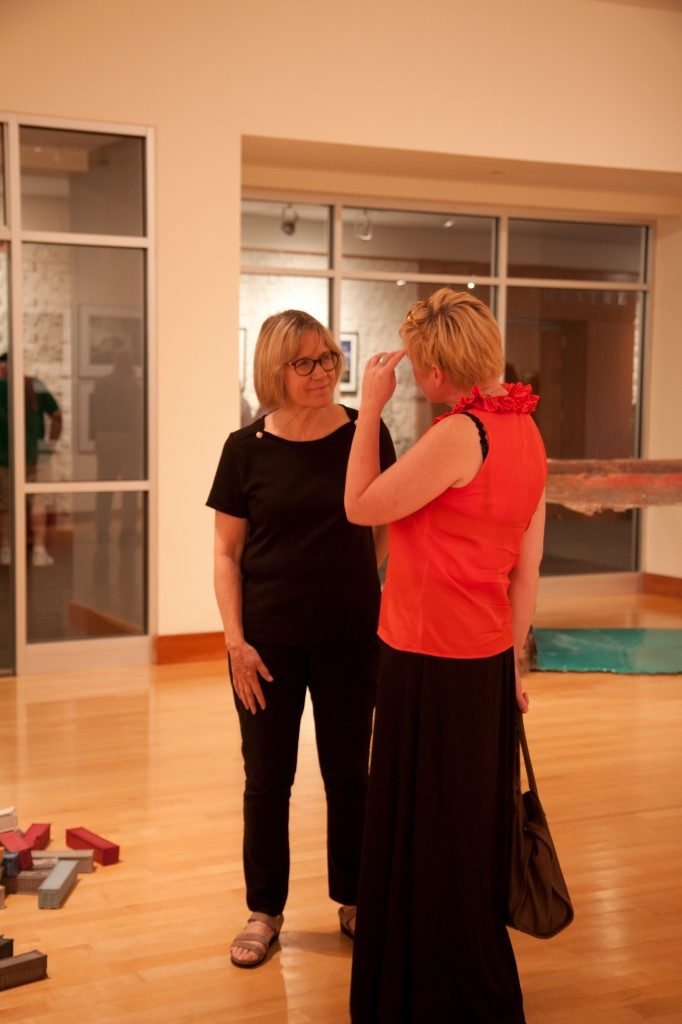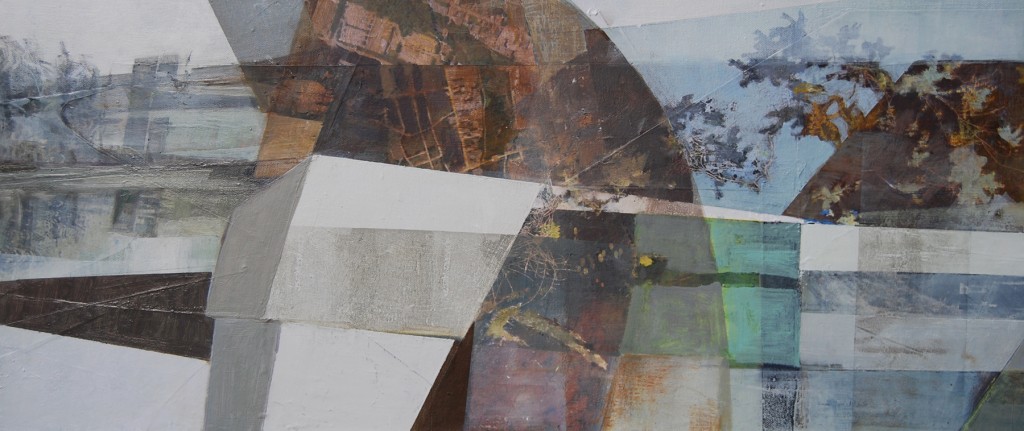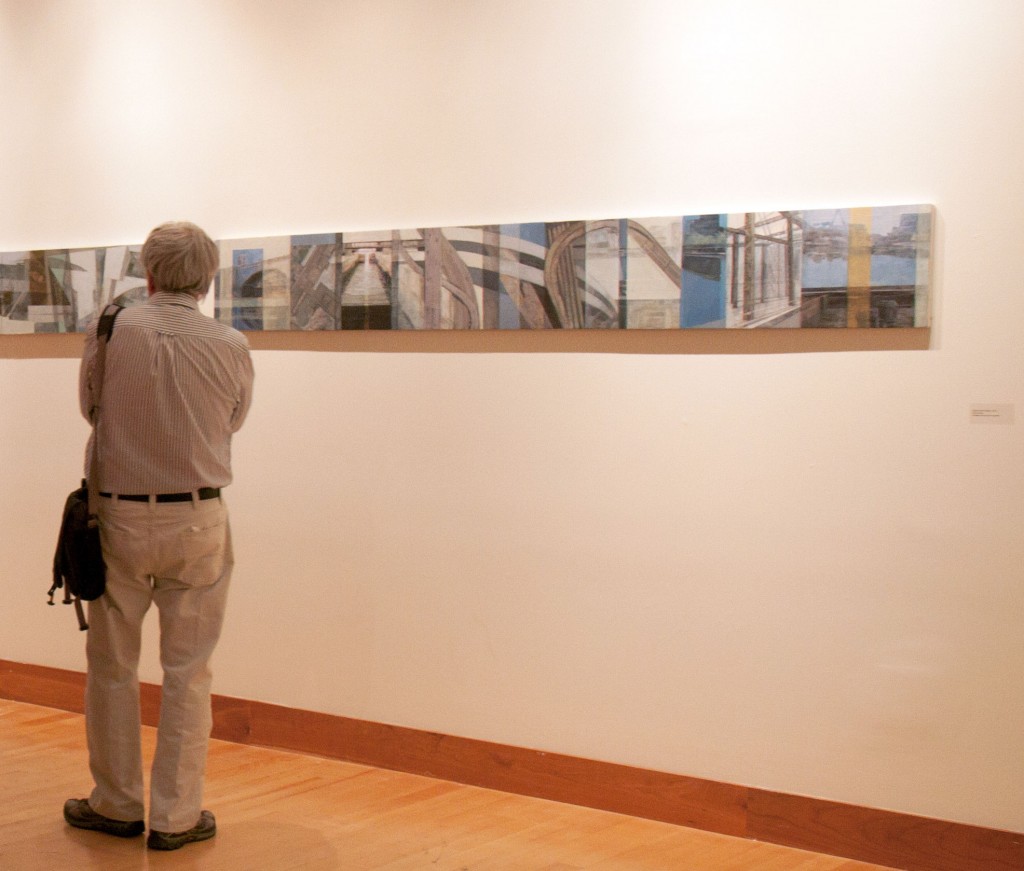Patricia Stone
Patricia Stone is one of five studio art professors whose artwork is featured in the exhibition “P3SF” in the Beard and Weil Galleries through October 31. In the early 1990s, Stone spent a year in Barcelona, Spain, where she first began working with sand, plaster and acrylic paint. In Barcelona, she developed paintings based on architecture and moved toward abstraction. In 2001, responding to 9/11, her work evolved to suggest aerial views, mapping and topography. More recently her paintings have focused on the Charles River and patterns of nature and urban growth. Here, we ask her about the intersection of her work as an artist and professor.
Q. How does what you do as an artist influence what you do as a professor and vice versa?
A. I teach what I use in my own studio every day. Basic lessons like perspective, color mixing and compositional balance are absolutely relevant to me through more than 30 years of artistic practice. I emphasize these foundational principles in my classes because I know how well they will serve my students over a lifetime. Being a professor is a wonderful job for an artist because it gives me a chance to share my passion with my students, talking about what I love to do. Engaging in that physical process of mixing paint or making charcoal lines on newsprint—the tactile element is something so timeless and basic. When students are engaging mind and body to create something, seeing their ideas emerge and become refined through the manipulation of materials, their excitement is infectious. I always want to keep that sense of discovery in my own work.
Q. What inspires your work as an artist?
A. My current work is inspired by the Charles River. I live nearby and walk there almost every day. It’s a beautiful place that feels like “wild” nature though it is surrounded by dense populations and major highways. When one is near the water, the density and architecture fade away, screened by the trees. One can see a lot of ducks and geese, turtles, gulls and thankfully, a reasonably healthy river. This is a precious resource that we can’t take for granted. The Charles River paintings reflect different parts of the river, a synthesis of multiple views and small details. I’m showing two parts of a triptych. “River Road” represents the mid-river near the crossing of I-95. “River Basin” is the end of the river just before it exits the locks of the Charles River Dam. I’m just beginning research for the first panel “Headwaters” this fall. I’ll be walking around Echo Lake and Hopkinton taking photos for source material.”
Q. Do your interactions with the students influence your work as an artist?
A. Not directly. But my interactions with students remind me of the importance of clarity, communicating ideas that are of interest to a broader range of people. It’s easy to become insular if one doesn’t connect much with popular culture. I tell students to work from what they know, use original sources, their personal experience, and then find connections to the larger historical culture.
Q. How does your work as an artist influence your mentoring of students?
A. I encourage students to find their own “voice” and pursue their passions. There is a great satisfaction in expressing what is most meaningful to you. Making art and making a living can be challenging but not mutually exclusive. Many of our students go on to graduate school or teach or work in design fields. Some find careers outside of the arts. But if they have formed a deep connection to their inner creative spirit, they will continue to make art whenever possible. Our students have a lot of good problem-solving skills that help them navigate a changing job market.
Q. What was your major and how did your time in college shape you as an artist?
A. I got a B.F.A. from the University of New Mexico and an M.F.A. in painting from the Yale School of Art. As an undergraduate, I followed the Photorealist movement. When I got to graduate school I had to re-learn to draw. I did a lot of remedial work from observation and the figure. It taught me the importance of foundations, having the skills that enable your work to move in any direction. It also made me question popular styles for their own sake. The artist always has two questions: “what do I have to say and how can I say it?”
Q. How do you balance your life as an artist with the demands of being a professor?
A. Time management is always a challenge. I don’t get much done during the school year but the ideas are always percolating. Teaching has its own creative demands. Summers and my “lite” semester with a two-course teaching load are my most productive times.
Q. It must be hard to do both so well. How do both enrich your life?
A. Painting and private work in the studio give me tremendous satisfaction but one can feel isolated. On the other hand, teaching is full of activity, talking and sharing ideas. I interact with a great community of students and faculty. Both sides contribute to the creative mind. I feel very lucky to be part of it.


